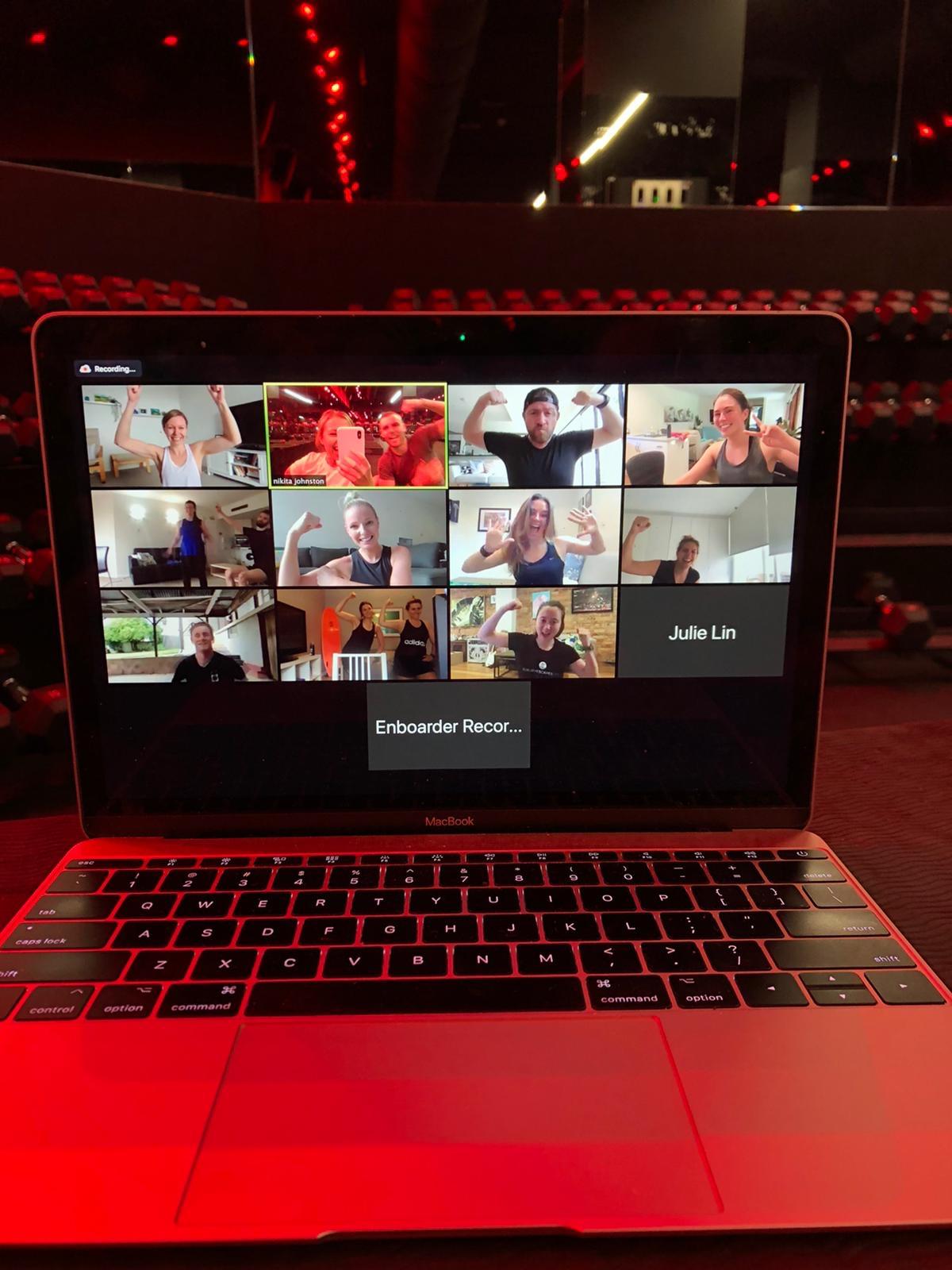How to Create a Kick-Ass Remote Employee Well-Being Program
UPDATED: 9 March 2023
It’s a fact: employee well-being programs produce demonstrable positive returns.
But creating a health and wellness program is no longer as easy as throwing some gym equipment in an abandoned office or having a massage therapist visit once a month.
There’s no doubt that today’s remote and hybrid world brings its own struggles, but 79% of employees said their company’s well-being programs helped them perform at their most productive level, and another 79% also believed these programs helped them avoid getting sick. The benefits easily outweigh the challenges.
In this blog, we’ll cover the top tips for creating functional and successful health programs that produce results on and off campus!
Now drop and give me 20!

1. Prioritize employee safety and mental health. 🥽
The very concept of employee well-being has shifted over the past several years, and while “workplace health” used to primarily refer to physical activity and dietary guidance, it now encompasses everything from protection from illness to mental health concerns.
With recent research from the APA finding that the majority of employees working from home report experiencing negative mental health impacts, including isolation, loneliness, and difficulty getting away from work, our focus on health and well-being needs to include these vital mental health elements.
Here are several ways you can help your employees stay refreshed and focused no matter where they’re physically located.
Create a safety resources hub.
Give your people a one-stop shop for all the info they might need, from company policies to the latest government health advice, and be sure to be open and transparent with all your communications. With so many changes, access must be as easy as possible.
Proactively announce any changes when applicable, and don’t rely on your employees to check in regularly for updates.
Be intentional in ensuring this information and any policy changes or announcements are made in a way that includes your remote and hybrid employees – not just your in-office teams – as these employees can often be overlooked.
Plan monthly virtual check-ins.
Business can’t be all about business.
Over two-thirds of workers aged 18-34 (67%) reported that making friends and maintaining relationships with colleagues was more challenging, and almost three-quarters (71%) said they felt like their work colleagues were more distant since working from home.
Now one in seven (70%) fear missing out on opportunities to socialize, and 81% of younger workers say they feel more isolated.
These aren’t just business needs. They’re emotional and human needs and must be supported and cared for.
As managers, mentors, and colleagues, we must contact our friends and co-workers regularly to ensure they feel seen and cared for.
Encourage socialization.
Don’t get us wrong, most employees prefer remote and hybrid work options to being in the office, but that doesn’t mean they want to be disconnected from work.
In fact, with most males, younger employees, and income earners over $100,000 reporting that they already feel disconnected, the opposite is true. Our people want to feel connected to their co-workers and have close interpersonal relationships at work.
Even though we desire these relationships, we can often forget to reach out or become too focused on our workload, which can leave us depressed and feeling isolated. For this reason, you should use tech like Enboarder’s Human Connection Platform to regularly send your people friendly nudges to remind them to take a break from the grind to make time for their friends and co-workers.
It may cost a little productivity in the short term, but you will gain the efficiencies of a healthy and motivated workforce in the long term!
Tackle presenteeism.
Presenteeism, or when your employees are physically at work but aren’t productive, costs businesses ten times more than absenteeism.
Per an Insights report by Global Corporate Challenge (GCC) that surveyed nearly 2,000 workers, employees reported taking an average of four days off per year for sick time, but this same group admitted to being unproductive an average of 57.5 days a year! That’s almost two months per year of unproductive time in the office!
To help overcome presenteeism, train your managers to spot the signs and, as The HR Director recommends, “shift your culture so […] your employees’ health is appropriately valued.”
*Note: Presenteeism can also affect remote workers, so be sure your hybrid and remote workers feel connected to their teams, regardless of location. Our research found that 82% of employees said they were more motivated to work on a program, and 84% found it easier to do their best work when they felt close to their team.
Remember to be present with them so they will be more present with their work.

Provide trusted resources.
Don’t just talk about mental health. Provide your employees with the help, tools, and resources they need to implement these strategies and practices.
Some examples of services and resources you can provide include:
- Employee Assistance Programs (EAPs) to help employees with personal or work-related problems – like legal problems, traumatic events, or relationship challenges – that may interfere with their ability to get their jobs done.
- Mental health self-assessments, like mental health quizzes, mood assessments, drug and alcohol assessments, and work-life balance surveys, so they can objectively understand where they stand from a mental health perspective.
- Free or subsidized depression screenings. Sometimes our people aren’t aware that they need help. Providing these services is part of our commitment to them as well.
As with your other resources, these must also be readily available for remote and hybrid employees. Make sure there are virtual options for all of the resources above!
Host mental health seminars.
The pandemic has brought the discussion of mental health at work to the forefront, and thankfully, this has made the concept of mental health less stigmatized.
To help further reduce any taboo around mental health topics, bring the conversation to light by inviting specialists to run virtual seminars around hot topics.
Don’t be intimidated by the thought of hosting a seminar – starting small is ok!
Involve your people in the entire process to help them understand which topics would be best to cover and how you can best market them to the larger organization. Emphasize that, like any other wellness program, this is part of employees’ overall health and that participation is good, even for “healthy employees.”
Also, remember that follow-up is essential. Give your managers helpful nudges with topics to help them continue checking in with their people and keep the conversation around mental health alive.
To make real change, training has to go beyond the classroom!
Provide access to counselors.
Education is great, but sometimes one-on-one support is a better option. Providing access to counseling services enables your people to get help if needed.
Make sure counseling services are available for your remote employees, and also take care to make sure your on-site employees are aware of the availability of these counseling services and that they understand that it’s OK and even encouraged to see these counselors during work hours. Ensure everyone understands that these services help productivity and shouldn’t be seen as distractions from “real work.”
Whether your employees are remote or in the office, be sure to send nudges to encourage them to keep their appointments, and set up another post-counseling nudge sequence to remind your employees to set up their next meeting and implement the things that they’ve learned during their sessions.
Encourage employees to have a morning routine.
The importance of a morning routine can’t be understated. Research has shown that a morning routine helps employees increase their happiness, reduce procrastination, boost their confidence, and improve their mood.
Starting the day with a feeling of accomplishment helps our people reduce stress, feel in control, prepare themselves for the rest of the day, improve their confidence, and develop other healthy habits.
It’s not a coincidence that the most successful people in the world have a morning routine.
While having a routine is important, the specifics of the routine are less important, so encourage your people to create a routine that works for them and helps them get closer to accomplishing their goals and being a better version of themselves.
Regardless of the specifics, here are some general guides and tips for a good routine:
- Have a fixed bedtime and waking time
- Avoid your phone in the morning
- Drink plenty of water
- Exercise or meditate
- Eat a healthy breakfast
These practices are easier with proper planning, so consider hosting a workshop to help your people develop their own personal morning routine.
Mental health mustn’t be the elephant in the room. Encourage a culture where people can freely discuss mental health by holding regular mental health chats.
Give everyone a meditation app subscription.
Meditation is a powerful tool for mental health. In fact, a 2018 clinical trial funded by the U.S. Department of Defense showed that meditation was as effective as prolonged exposure therapy at reducing PTSD symptoms and depression!
But, as with most things, meditation is a very personal practice, and it’s hard to host or enable in a large group setting like a class.
For this reason, meditation apps are perfect because they live on your employee’s phone and can be accessed whenever your people have a moment to themselves. Depending on the app, they can also provide personalized nudges to encourage your employees to keep going and help them establish a daily meditation routine.
There are plenty of options for meditation apps available, and they range from about $8.00/month to $50.00/month, depending on the specific app and features. If you don’t want to decide for your people, consider offering a stipend so they can pick the app that works best for them.
Encourage your people to take a break from the endless barrage of social media and email and take a moment for themselves with a meditation app.
Give out more mental health days.
As a summary of our points above, giving employees the necessary breaks and space reduces presenteeism and produces countless benefits.
According to the Mayo Clinic, providing employees with mental health days results in reduced burnout, improved morale and attitude, improved resiliency, reduced feelings of isolation and loneliness, prevention of mental health crises, increased productivity, and even improved physical health from the alleviation of chronic stress.
Encourage your employees to be intentional with their time to get the most out of their mental health days. Don’t just use it as a day to sleep in!
Encourage your employees to use this time productively – turn off social media and go for a hike, review your goals, or practice a creative outlet. When your employees return to work, they’ll be truly refreshed and ready for their next challenge!
Be mindful that your employees may not take the mental health days they need because they fear the stigma or potential judgment. Be intentional with your messaging showing that your organization supports good mental health!

2. Encourage healthy eating. 🥦
According to the CDC, adults who eat a healthy diet live longer and have a lower risk of obesity, heart disease, type 2 diabetes, and even certain cancers. This translates to higher productivity due to fewer sick days, better mood, and increased energy!
One of the best and easiest ways to help your employees feel their best is by providing food education and healthy snacks where available – your employees are already going to eat, so you may as well help them turn to a healthy alternative!
Here are a few practical tips on encouraging healthy eating in your workplace!
Share healthy snack recipes.
Simply providing healthy snacks in the office won’t help your remote and hybrid workers feel their best, but sharing healthy snack recipes with them certainly can!
Start a Teams or Slack channel and encourage employees to post links or recipes for the healthy snacks that they use to keep them energized throughout the day.
So often, we make poor snacking decisions simply because we can’t find a better option within reach. Be proactive and consider even creating shopping lists from some of these recipes to help your employees load their carts and be sure they have healthy options at home.
This is another place where mobile apps can help, as many different meal-planning apps are available to meet each dietary and lifestyle need. There are multiple grocery list apps that you could integrate with to help remove another bit of complexity from your people’s lives.
Send healthy snack subscription boxes.
Are your people too busy to prepare their own snacks? No problem!
You can also use a plethora of snack subscription box services to proactively send your employees healthy snacks they’ll enjoy without having to go to the store!
Signing your employees up to receive snack subscription boxes will help improve their mental clarity and productivity by providing them with nourishing snacking alternatives while not requiring them to leave their home offices. These can also add excitement and enjoyment to their day when they unpack their boxes to see what snacks have arrived!
When choosing a service, consult with your employees first so you’re aware of any dietary restrictions and snacking preferences. You want to deliver joy, not junk!
Run a virtual healthy cooking class.
The pandemic plus rising costs due to inflation means that more and more people are looking for alternative options to dining out. An IRI OmniConsumer survey from July 2022 found that 78% of meals were being prepared at home, compared with 48% in 2019!
That said, just because more people are cooking at home doesn’t mean they’re picking healthier options. Many people are intimidated by the thought of cooking or simply don’t know how, so they rely on processed and packaged foods for their meals.
Hosting a virtual cooking class is a fun way to help educate and encourage confidence in your potential at-home cooks!
Now, don’t feel pressured to try to get a big-name celebrity – several of your employees are likely talented home chefs and would have the perfect personality to have fun hosting such an event.
It can be as simple as encouraging your employees to participate and show off their best recipes on a zoom call; everyone will benefit from the delicious experience!
Create a collaborative office cookbook.
What could be more fun than sharing your best recipes?
Crowdsourcing healthy cooking inspiration helps your people on their journey to eating well while fostering a sense of community, and there are a ton of benefits for everyone involved.
Picking their favorite recipes helps your employees stir up fond memories. Seeing a co-worker’s name tied to a recipe gives each meal a new dimension, and your contributors will feel proud and encouraged when they see their very own recipe published in a book – there’s no downside!
Give your cookbook a fun name and publish it internally to create a company asset everyone’s proud to have been involved with.
Implement healthy eating initiatives.
Some people feel overwhelmed at the thought of lifestyle changes, and others don’t know where to begin making changes. Healthy eating initiatives can be a great way to help these people ease into a healthier lifestyle by outlining small steps that lead to bigger changes.
Running non-compulsory initiatives like meat-free Mondays and Dry July could help put healthier habits front of mind and give your people more clear and attainable targets and goals.
By focusing on a smaller change, attaching a timeline to the challenge, and getting the community involved, healthy eating initiatives give your people a friendly, supportive way to start making these positive changes in their lives.
Provide access to nutritionists.
Is coconut oil good or bad for you? What about wine?
The amount of information online is dizzying, so help your employees get clear answers easily without having to put in hours of research by giving them access to a nutritionist. A nutritionist will be able to work with your employees individually and offer them meal plans, tips, and ideas that will work with their unique lifestyles and dietary restrictions.
Also, giving your employees access to the same nutritionist over time will help them understand and track their changes and progress and ensure they can stick with their program.
Your nutritionist doesn’t always have to be physically available (especially since many of your employees may not be physically in your facility), but they should be available by Zoom or email, SMS, etc., so your employees can get the answers they need, wherever they are.

3. Promote physical activity. 🏃♀️
While nutrition is undoubtedly key to employee health, physical activity is also vitally important.
According to the World Health Organization, physical activity has significant health benefits for hearts, bodies, and minds, including preventing and managing noncommunicable diseases, reducing depression and anxiety, enhancing thinking, learning, and judgment skills, and improving overall well-being.
Unfortunately, the WHO also reports that one in four adults doesn’t reach the global recommended levels. But this means you have an excellent opportunity to help drive positive change in your workplace!
Host virtual exercise classes.
The most powerful thing about exercise classes is their community feel and the slot they own on the calendar. They’re something employees prepare and schedule time for (which means they usually keep their commitments), and exercising with others gives them a deeper sense of connection and community.
Just because your employees may not be in the office anymore doesn’t mean that exercise classes are a thing of the past!
Your people can maintain those same elements of community and routine and even expand them to include your remote and hybrid employees with virtual exercise classes. These classes still give them the opportunity to meet others and form deeper connections by introducing each other and sharing encouragement in the chat, but it also allows them to get the same benefits of exercise without having to drive to a different location or pack an extra set of clothes.
Share fitness tips.
Similar to nutritional information, the internet is often littered with conflicting information about fitness. Is running good, or is it bad for your knees? Should your knees go over your toes when you squat?
Creating a Slack or Teams channel to help your people share fitness tips with each other can help give them an easy resource they can check to see what tips are working well for their co-workers. It can also help them establish new connections and build a stronger sense of community.
Being helpful and sharing tips and knowledge will help your employees feel knowledgeable and valued. You might find that networks like these are one of the most effective ways to spur conversations between employees in different teams within your company.
Run team fitness challenges.
Sometimes you need some healthy competition in your life (pun intended)!
Like healthy eating initiatives, team fitness challenges also help make something intimidating (e.g., “Get in shape”) into something much more approachable and manageable by breaking the broader concept into smaller pieces and offering support and encouragement from teammates.
Some fun and unique fitness challenges could include healthy hobby challenges, walking challenges, “take the stairs” challenges, exercise challenges (like squat challenges), biggest loser competitions, “exercise for a cause” participation, or even just a get outside challenge.
Remember, the most effective part of this program is the community aspect. Make sure you create an ecosystem (via a dedicated Slack channel or similar) where it’s easy for co-workers to get involved and support each other. Consider making awards or celebration ceremonies and ensuring you’re creating enough variety so everyone can participate.
Subsidize fitness wearables.
How many steps have you taken today?
In some ways, putting in and tracking physical activity was easier when we were in the office (at the very least, most of us had to travel to get to work!), but many of these activities are harder to track in our remote and hybrid environments.
Now, many of our commutes consist of a walk from the bedroom to the bathroom to the table, and we can let a whole day go by without taking a single step outside.
Fitness wearables are a great way to help your employees ensure they’re getting sufficient physical activity regardless of where they’re physically located. Also, fitness tracker technology has evolved beyond simple step counters and heart rate monitors, with many even integrating with 3rd party apps like Strava to enable a supportive community element.
Provide a home gym stipend.
Let’s face it, between lockdowns and regulations, getting to the gym has been difficult over the past couple of years. Working from home has also made going to the gym more difficult, as we can’t just swing by on our way home. But, just because your employees may be spending more time at home, doesn’t mean they can’t still get some good exercise in!
Providing a stipend for exercise equipment is a great way to help your employees get active and feel great no matter where they are.
Now, this doesn’t mean that your employees need to go out and buy a $1,500 Peloton. From resistance bands to kettlebells and exercise balls to jump ropes, there are many simple and cost-effective options for home fitness equipment to help your employees feel their best on a budget.
Sometimes all we need is a new pair of running shoes to take a walk outside. Don’t let a lack of equipment hold your people back from getting the physical activity they need.

4. Optimize home offices. 🖥
Most of us didn’t buy our homes with our jobs in mind. We assumed we’d have all of our “work stuff” in the office and bought our home with different considerations. Now for many of us, our homes have become our offices, and we often find ourselves in situations where they’re not terribly efficient.
Whether it’s limitations in internet speed, a lack of functional furniture or accessories, or even the fact that we may not have access to any quiet spaces, there’s nothing more frustrating than when we can’t get our work done because of a limitation in our home office.
Help remove the home office limitations from your employees so they can feel free to do their best work wherever they are!
Buy/loan ergonomic home office equipment.
When we first shifted to work from home, many of us sat on the couch or at the kitchen table with our laptops. We would have called this an ergonomic nightmare in the office, but now we just call it working from home.
Now it’s not uncommon for our remote and hybrid employees to report feeling things like neck and shoulder pain, eye fatigue, tight hips, wrist pain, backaches, and even leg cramps – all symptoms of a poor work-from-home environment – and these can all lead to lasting detrimental health effects which will be reflected in your health expenditures.
Putting in some investment on the front end with a home office equipment lease or stipend will help your employees perform at their best by providing them with the equipment they need to work comfortably and safely.
As far as the logistics, there are several ways to make leasing office equipment work effectively, but if the majority of your team is remote or distributed across the globe, it may be easier to simply offer a stipend so they can choose the furniture and equipment that works best for them.
Subsidize a houseplant.
Something that’s often overlooked and incredibly inexpensive to implement is subsidizing a houseplant.
In addition to giving your employees something to care for and providing some much-needed oxygen, studies have shown that adding houseplants to a barren office space has been shown to increase productivity by 15% and decrease negative feelings by 58%.
Replicate those results with your remote workers! Encourage them to brighten up their home offices by subsidizing a houseplant and start a group channel where people can share the plants they’ve selected and report on how they’re growing over time!
It’s a small, inexpensive gesture but it’s unique and speaks volumes.
Subsidize internet upgrades.
Is there anything more annoying than watching that little spinny dial as you’re waiting for a page to load?
Most base home internet plans can’t keep up with the heavy upload and download data demands that our jobs often require – especially when everyone in our neighborhood is trying to do the same thing at the same time and low internet speeds can mean everything from a loss of productivity and prematurely giving up on tasks that take too long to heavily pixelated Zoom calls and dropped connections.
These days, our internet connection is literally our connection to the outside world, so our people must have a sufficient and reliable internet connection with adequate speeds.
Ensure your employees have enough bandwidth to do their jobs effectively. When you consider the alternative, it’s a small price to pay.
Subsidize data storage plans.
Laptops were optimized for portability. They weren’t designed for the sheer amount of storage that most of our businesses require (This is especially true for creatives and engineers who can be working with very data-intensive objects and applications).
So, even though the technology is improving, your employees might be bouncing off of storage limits or suffering from slow equipment due to overtaxed storage. In addition to helping our employees with subsidies for office equipment, don’t forget to help them with their data storage needs as well.
Nowadays, there are a variety of cloud data storage options available, each with its own advantages, but before you make a purchase, make sure you explore your current corporate software stack to see if you have any options that you’re already paying for but maybe not using to the fullest extent.


5. Reinforce work/life balance. 🎳
With more of us working from home, the line between where work ends and when our personal lives begin has become blurred.
Put more simply, it used to be easier to leave work at work when we were actually at work.
We know that good work-life balance helps increase employee productivity, reduce turnover, and improves mental and physical health (HBR even found that work-life balance even helps increase diversity!), but getting our employees to take a break despite the pressures of work is much more difficult.
Here are a few tips to help your employees take a break and establish a good work-life balance.
Enforce breaks!
There can often be a negative stigma around taking breaks – that you’re not working hard if you’re not working around the clock – but this couldn’t be further from the truth.
In fact, studies have shown that taking regular breaks can actually help you be more productive and improve recall by helping you reduce stress levels and get a much-needed reset.
Help break the stigma by reinforcing the value of taking breaks and requiring your employees to take breaks when they feel overloaded.
One method is to have clear and enforced offline times so that employees know it’s an expectation to take breaks, and they won’t feel judged for taking a pause.
We need to stress the importance of our people not just “doing work” but doing their best work, and that only comes when they take the necessary time to relax and refresh themselves.
Support flexible work hours.
When do you feel most energized and creative?
Some people feel most productive in the mornings, while others have more “afternoon energy” (and still others feel their creativity opens up late at night). While it’s important that our employees have some predictability with their working hours so other employees know when they can be contacted, it’s important to give your people the freedom to work when it fits best with their schedules and energy levels.
A study from Remote found that 75% of workers considered flexible working hours the most important employee benefit when considering a job move (ranking higher than company-sponsored retirement plans or pensions, early finish on Fridays, a four-day work week, and even family health insurance).
Clearly, our people are asking for flexibility, so we need to be sure we’re actively encouraging flexible hours and not just leaving it as a bullet point on our job listings.

Provide reasonable workloads.
Surprise! What was a reasonable workload yesterday might not be today.
Fast Company identified the four main drivers of overwork as motivational (people who are compelled by internal pressures), cognitive (people who can’t stop thinking about work), emotional (people who experience anxiety or guilt when they’re not working), and behavioral (people who work well beyond what’s expected of them), and all of these are made worse by work from home.
At least when people had to drive to the office, their work and home life happened in two different locations. Now that work and home life often cohabitate in the same space, it’s even harder for each of those four personas to unplug from work.
In our current environment, it’s so much easier to put in extra hours (you only need to flip open your laptop), so we need to be sure that we’re providing a reasonable workload, so our employees can unplug when they need to and not feel pressured to fill every waking moment with work.
Incentivize travel.
While our people need to occasionally unplug from work, not all breaks are created equal. Some breaks, like scrolling social media, can negatively impact our employees, so we need to encourage the right activities that will most help our people recenter and reengage feeling refreshed.
Travel is an excellent way to help our people to relieve stress, boost morale, open their minds, and even make them fall in love with their jobs even more.
To encourage travel, you can do everything from offering paid vacations or travel packages as a perk or a reward for performance all the way down to simply allowing flexible time off and fostering an office culture that encourages breaks, time off, and vacations.

6. Support financial health. 💰
In this time of layoffs, recession, and unprecedented inflation, financial uncertainty is at the top of everyone’s minds. How can our employees focus on work when they’re concerned about their savings and financial future?
To our employees, financial stability symbolizes the safety and security of their family’s futures, so taking small steps to help our employees feel more secure will pay dividends in their productivity, morale, and attitude to work.
Here are a few ways you can help your employees feel more stable.
Offer loans or grants.
Loans and grants aren’t only a business-to-business thing: They can help our employees through hard seasons.
Sometimes our employees might be going through a tough time (e.g. when an unexpected medical event happens). These moments allow our companies to be more human and help our employees in their times of greatest need.
Some examples of ways we can help our employees include providing a salary advance or modifying our payment schedules and/or giving shopping vouchers to help make sure our employees have access to the necessities they need to support themselves and their families.
Remember, we must remove the stigma around programs like these. Accepting help doesn’t make these people “less than.” We will all experience hard times, and this is when we need each other the most.
Create a financial resource hub.
Short-term loans may help our employees get out of a sticky patch, but offering financial education can be life-changing.
While a wealth of financial information is available online, much of this information can be confusing and potentially conflicting. Having a resources hub that makes this information easily accessible and provides a single source of truth can help employees learn and feel more confident in their financial decisions. You can also offer a dedicated group or private chat where people can feel comfortable asking whatever financial questions they have and get relevant support and assistance.
You can also host virtual seminars from personal finance experts and host them in the hub so employees can access them at their convenience.
Provide financial planning and coaching.
There’s no one-size-fits-all solution to financial planning.
Everybody’s financial situations and goals are different, so providing access to financial planning and coaching can be a game-changer in helping your employees feel confident and secure in their financial choices.
When it comes to implementation, there are a few different ways to offer these programs to your employees. You can provide group education through seminars, or if you’re a larger company, you can see if your retirement plan provider offers this service as a low or no-cost add-on.
Without a doubt, hiring a coach who can work with employees at an individual level will be the most helpful (as resources like educational workshops tend to favor employees who are already more financially motivated or proactive), but it may not be economically feasible for your company. In these cases, consider offering a reimbursement program or stipend to help your employees offset some of the costs of hiring a financial planner or coach (even if it’s just for an initial session to get a baseline).
If you take the above route, maintain a list of quality, trusted financial advisors in your finance resource hub.
Another option is to hire a financial planner to offer individual meetings for employees once or twice per year. While this won’t provide the same in-depth support as reimbursing employees for their advisement expenses, you’ll likely see a higher level of participation, especially from younger employees or employees who feel more anxiety or shame around their finances.
No matter your choice, you can’t lose by giving your employees more support to help them feel more financially secure!
Implement an employee discount program.
If you’re a larger company or can establish partnerships with local area businesses, implementing an employee discount program can be super helpful for your employees to get savings and reduce expenses.
Here are a few ideas you can implement regardless of your company size:
- Offer in-house discounts: Even if you’re not a large company, if your products are things that your employees would use, consider offering them a discount to purchase from you.
- Flex your L&D budget: Not every discount has to be for tangible things. Offering your employees discounts or reimbursements for picking up additional education or training helps show your people that you’re committed to investing in their future success, and they’ll thank you for it. (Offering discounts on mental health services like group meditation classes would also fall into this bucket.)
- Look to your vendors: Do any of your vendors offer products or services your employees would find helpful? Be sure to explore your IT and facilities vendors as well, as they may offer discounts on such things as cleaning services, computers, printing services, etc.
- Connect with a discount dealer: It’s OK if you can’t get a large number of discounts on your own. Some companies literally exist for this purpose (some include BetterWorks, PerksCard, Next Jump, or Abenity). These companies can also often help you set up an employee portal or page to help them see all of their available discounts.
- Buy lunch: Hey, everybody needs to eat lunch, right? Offering discounts or free lunches (or subscriptions like the healthy snack boxes we mentioned above) is a fun and appreciated way to show that you appreciate your employees and want to help pick up the tab every once in a while.
Support remote employees with solutions from Enboarder.
Our most recent survey found that 94% of employees agreed that they’re more productive when they feel connected to their colleagues, and employees who felt connected were over four times more likely to say that they were “very satisfied” with their jobs and half as likely to leave within the next 12 months.
Our employee’s well-being at work is directly tied to their feelings of connectedness with those with whom they work.
All details aside, this means that consistency and communication are the most important things we can offer our remote and hybrid employees. And the best way to ensure that your communication is standardized and not left to chance is with Enboarder’s Human Connection Platform.
With Enboarder, you can set up no-code best-practice workflows that trigger nudges and key communications at the right times to implement all of the abovementioned strategies while ensuring that no employee is left unsupported or feels left out. And, since you can upload pre-built templates, Enboarder allows your managers to easily keep up with their employees without having to worry about writing new communications every time or fumbling with dozens of log-ins.
So, how can you help your employees feel connected, secure, and supported?
Check out Enboarder and set up your timely, relevant messaging and communication strategy today!